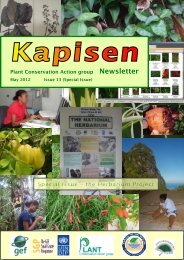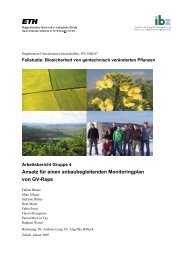Kapisen - ETH Zürich
Kapisen - ETH Zürich
Kapisen - ETH Zürich
Create successful ePaper yourself
Turn your PDF publications into a flip-book with our unique Google optimized e-Paper software.
P r o t a r u m s e c h e l l a r u m<br />
Protarum sechellarum, the only endemic<br />
Araceae of the Seychelles<br />
Josef BOGNER and Susanne S. RENNER<br />
Munich Botanic Garden<br />
renner@lrz.uni-muenchen.de<br />
Summary<br />
Protarum sechellarum (Larourout dilenn maron)<br />
belongs to the same family as the edible Cocoyam<br />
(Larouy or Taro) and the invasive duckweeds and<br />
Water Lettuce that threaten to smother waterways and<br />
marshes. However, Larourout dilenn maron grows in<br />
forests and is endemic to Seychelles. Protarum has<br />
flowers that are rather primitive in form, and it seems<br />
that this species is another ‘relict’, surviving from the<br />
time when the Seychelles split away from the Indian<br />
sub-continent. Protarum has an underground tuber<br />
(Fig. 1) and a single leaf divided into around 7 to 11<br />
leaflets (Fig. 2). The flowering part is not often seen<br />
as it is not brightly coloured. It consists of a leafy<br />
cover (spathe), inside which is a finger-like flower<br />
stalk (spadix) (Fig. 3) that has male flowers on the<br />
middle part and female flowers at the base (Fig. 4).<br />
The obovoid fruits also form at the base, turning<br />
orange when ripe.<br />
The family of the Araceae<br />
The Seychelles have only one endemic Araceae,<br />
Protarum sechellarum Engl. (Larourout dilenn maron).<br />
Araceae are a family of herbaceous monocots with<br />
108 genera and about 3750 species. Morphological<br />
and molecular data indicate that duckweeds<br />
(Lemnaceae) are nested within Araceae and hence<br />
should be included in that family. Duckweeds and<br />
Water Lettuce (Pistia stratiotes L.) are the only<br />
free-floating aquatic Araceae, and both exist on<br />
the Seychelles as invasive plants. The majority of<br />
Araceae, however, occur in the New World tropics,<br />
and life forms range from submerged or free-floating<br />
aquatics to terrestrial, epiphytic, or hemiepiphytic<br />
herbs or climbers. The easiest way to recognize an<br />
Araceae is the distinctive inflorescence, a spadix with<br />
bisexual or unisexual flowers, subtended by a solitary<br />
bract called spathe. On the Seychelles, the family is<br />
also represented by a few introduced horticultural<br />
or edible species, for example, Colocasia esculenta<br />
(L.) Schott.<br />
The late discovery of Protarum sechellarum was<br />
described in 1901 by the German botanist Adolf<br />
Engler. The material that Engler worked on had been<br />
Fig. 1 Tuber and old inflorescence of<br />
Protarum sechellarum (J Bogner).<br />
collected by A. F. W. Schimper in March 1899 during<br />
the Valdivia Deep Sea Expedition. During a four-day<br />
stay on the main island of Mahé, Schimper had a<br />
chance to visit the forests on Mt. Harrison. Since<br />
then, Protarum has also been discovered at other<br />
localities on Mahé, such a Morne Blanc, Copolia,<br />
Cascade Estate, Congo Rouge, and Casse Dent, as<br />
well as from localities on the islands of Silhouette and<br />
Praslin. On Praslin, it occurs together with Lodoicea<br />
maldivica (Gmelin) Pers. in the Vallée de Mai.<br />
Illustrations of Protarum sechellarum have appeared<br />
in Hooker‘s Icones Plantarum (1902, pl. 2750) and<br />
in Rosemary Wise‘s (1998) book with paintings of<br />
endemic plants of the Seychelles, „A Fragile Eden.“<br />
Description of Protarum<br />
Protarum sechellarum is a seasonally dormant<br />
herb with a subglobose tuber that can reach 12 cm<br />
in length and 8 cm in diameter (Fig. 1). The plant<br />
typically has a single leaf, the dissected blade of<br />
which can reach c. 80 cm in diameter and can have<br />
(5-)7-11 leaflets, each about 25-40 cm long and 8-<br />
10 cm wide (Fig. 2). The inflorescence is solitary<br />
and can appear before the leaf or simultaneous<br />
with it (Fig. 3). The spathe of the inflorescence<br />
is 13-18 cm long and the spadix, which bears the<br />
flowers, 8-12 cm. The flowers are unisexual, with the<br />
female ones borne basally on the spadix, the male<br />
ones more distally. The flower-bearing zones are<br />
separated by a sterile section with fused and muchreduced<br />
stamens (called synandrodes; Fig. 4), and<br />
the spadix then ends in a terminal appendix up to<br />
K a p i s e n 7 I s s u e 3







